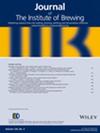求助PDF
{"title":"The enhanced susceptibility of alcohol-free and low alcohol beers to microbiological spoilage: implications for draught dispense","authors":"David E. Quain","doi":"10.1002/jib.670","DOIUrl":null,"url":null,"abstract":"<p>The spoilage of six alcohol-free (AFB, ≤ 0.05% ABV) and two low alcohol beers (LAB, ≤ 1.2% ABV) was assessed by challenge testing with microflora from draught beer. Spoilage of AFB and LABs was greater (2-5 x) than two ‘control’ premium lager beers (4.5% ABV). Measurement of spoilage by challenge testing was reproducible irrespective of the source of draught beer microflora (public house, date, or beer style). Spoilage was correlated with the level of ‘fermentables’ (glucose + fructose + maltose) in the product but was also dependent on the availability of micronutrients. The addition of ethanol (2-8% ABV) to three AFBs and a LAB resulted only in a modest inhibition of spoilage (collectively 24% at 8% ABV) and, it is suggested, that the complexity of the product composition provides protection. Given the vulnerability of AFBs and LABs to spoilage and susceptibility to microorganisms that are usually supressed by ethanol, it is strongly recommended that low or alcohol-free beer styles are not offered to consumers in the on-trade by conventional long line dispense systems. It is suggested that AFB and LABs in a draught format require innovative, hygienically designed stand-alone dispense systems that remove or significantly minimise the risk of microbiological contamination, growth and associated product spoilage. © 2021 The Institute of Brewing & Distilling</p>","PeriodicalId":17279,"journal":{"name":"Journal of The Institute of Brewing","volume":null,"pages":null},"PeriodicalIF":2.4000,"publicationDate":"2021-10-07","publicationTypes":"Journal Article","fieldsOfStudy":null,"isOpenAccess":false,"openAccessPdf":"","citationCount":"2","resultStr":null,"platform":"Semanticscholar","paperid":null,"PeriodicalName":"Journal of The Institute of Brewing","FirstCategoryId":"97","ListUrlMain":"https://onlinelibrary.wiley.com/doi/10.1002/jib.670","RegionNum":3,"RegionCategory":"农林科学","ArticlePicture":[],"TitleCN":null,"AbstractTextCN":null,"PMCID":null,"EPubDate":"","PubModel":"","JCR":"Q3","JCRName":"FOOD SCIENCE & TECHNOLOGY","Score":null,"Total":0}
引用次数: 2
引用
批量引用
Abstract
The spoilage of six alcohol-free (AFB, ≤ 0.05% ABV) and two low alcohol beers (LAB, ≤ 1.2% ABV) was assessed by challenge testing with microflora from draught beer. Spoilage of AFB and LABs was greater (2-5 x) than two ‘control’ premium lager beers (4.5% ABV). Measurement of spoilage by challenge testing was reproducible irrespective of the source of draught beer microflora (public house, date, or beer style). Spoilage was correlated with the level of ‘fermentables’ (glucose + fructose + maltose) in the product but was also dependent on the availability of micronutrients. The addition of ethanol (2-8% ABV) to three AFBs and a LAB resulted only in a modest inhibition of spoilage (collectively 24% at 8% ABV) and, it is suggested, that the complexity of the product composition provides protection. Given the vulnerability of AFBs and LABs to spoilage and susceptibility to microorganisms that are usually supressed by ethanol, it is strongly recommended that low or alcohol-free beer styles are not offered to consumers in the on-trade by conventional long line dispense systems. It is suggested that AFB and LABs in a draught format require innovative, hygienically designed stand-alone dispense systems that remove or significantly minimise the risk of microbiological contamination, growth and associated product spoilage. © 2021 The Institute of Brewing & Distilling
无酒精和低酒精啤酒对微生物变质的敏感性增强:对生啤分配的影响
采用生啤微生物菌群攻毒试验,评价了6种无酒精啤酒(AFB, ABV≤0.05%)和2种低酒精啤酒(LAB, ABV≤1.2%)的腐败程度。AFB和LABs的腐败比两种“对照”优质拉格啤酒(4.5% ABV)更大(2-5倍)。不管生啤菌群的来源(酒吧、日期或啤酒类型)如何,挑战试验对腐败的测量都是可重复的。腐败与产品中“可发酵物”(葡萄糖+果糖+麦芽糖)的含量有关,但也取决于微量营养素的可用性。将乙醇(2-8% ABV)添加到三个afb和一个LAB中,只产生了适度的腐败抑制作用(在8% ABV下总共抑制了24%),这表明,产品组成的复杂性提供了保护。鉴于afb和实验室的脆弱性,腐败和易感性的微生物,通常被乙醇抑制,强烈建议低或无酒精啤酒风格不提供给消费者在贸易中通过传统的长线分配系统。建议AFB和实验室在草稿格式中需要创新的,卫生设计的独立分配系统,以消除或显着降低微生物污染,生长和相关产品腐败的风险。©2021 The Institute of Brewing;蒸馏
本文章由计算机程序翻译,如有差异,请以英文原文为准。


